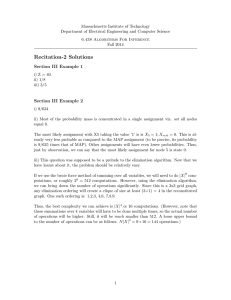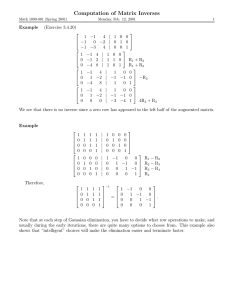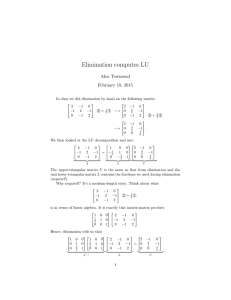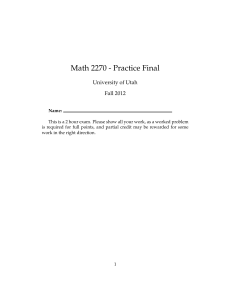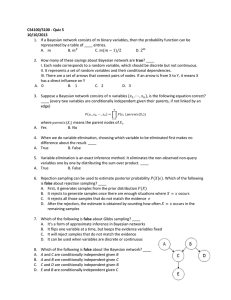Methods for Constructing Balanced Elimination Trees and Other Recursive Decompositions Kevin Grant
advertisement
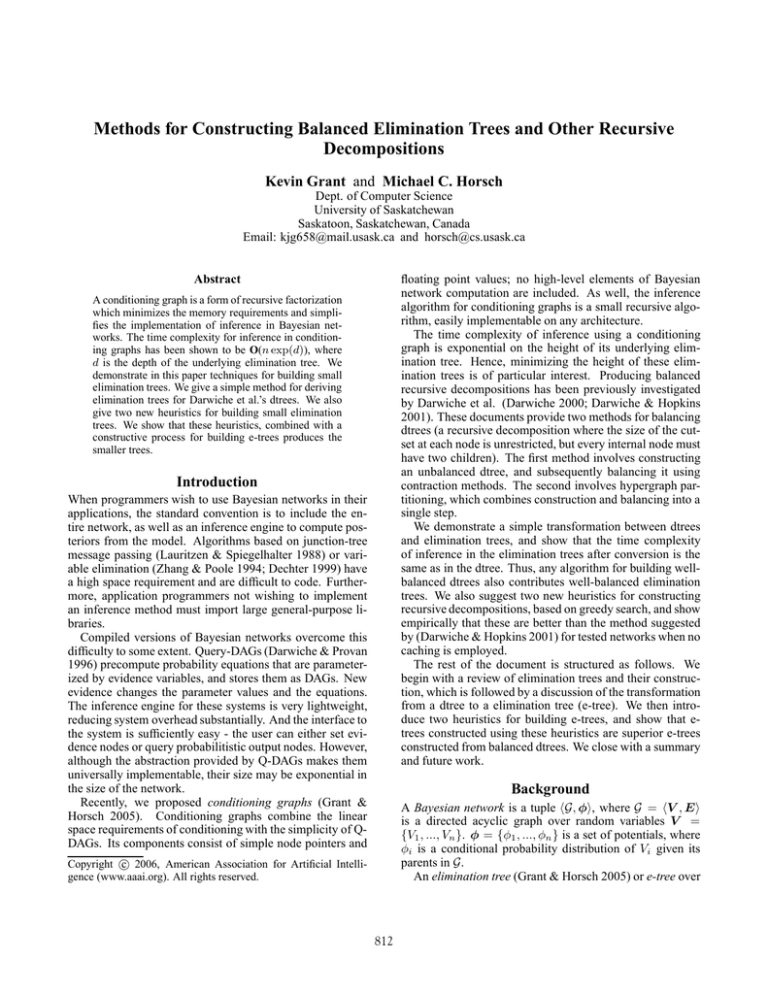
Methods for Constructing Balanced Elimination Trees and Other Recursive
Decompositions
Kevin Grant and Michael C. Horsch
Dept. of Computer Science
University of Saskatchewan
Saskatoon, Saskatchewan, Canada
Email: kjg658@mail.usask.ca and horsch@cs.usask.ca
floating point values; no high-level elements of Bayesian
network computation are included. As well, the inference
algorithm for conditioning graphs is a small recursive algorithm, easily implementable on any architecture.
The time complexity of inference using a conditioning
graph is exponential on the height of its underlying elimination tree. Hence, minimizing the height of these elimination trees is of particular interest. Producing balanced
recursive decompositions has been previously investigated
by Darwiche et al. (Darwiche 2000; Darwiche & Hopkins
2001). These documents provide two methods for balancing
dtrees (a recursive decomposition where the size of the cutset at each node is unrestricted, but every internal node must
have two children). The first method involves constructing
an unbalanced dtree, and subsequently balancing it using
contraction methods. The second involves hypergraph partitioning, which combines construction and balancing into a
single step.
We demonstrate a simple transformation between dtrees
and elimination trees, and show that the time complexity
of inference in the elimination trees after conversion is the
same as in the dtree. Thus, any algorithm for building wellbalanced dtrees also contributes well-balanced elimination
trees. We also suggest two new heuristics for constructing
recursive decompositions, based on greedy search, and show
empirically that these are better than the method suggested
by (Darwiche & Hopkins 2001) for tested networks when no
caching is employed.
The rest of the document is structured as follows. We
begin with a review of elimination trees and their construction, which is followed by a discussion of the transformation
from a dtree to a elimination tree (e-tree). We then introduce two heuristics for building e-trees, and show that etrees constructed using these heuristics are superior e-trees
constructed from balanced dtrees. We close with a summary
and future work.
Abstract
A conditioning graph is a form of recursive factorization
which minimizes the memory requirements and simplifies the implementation of inference in Bayesian networks. The time complexity for inference in conditioning graphs has been shown to be O(n exp(d)), where
d is the depth of the underlying elimination tree. We
demonstrate in this paper techniques for building small
elimination trees. We give a simple method for deriving
elimination trees for Darwiche et al.’s dtrees. We also
give two new heuristics for building small elimination
trees. We show that these heuristics, combined with a
constructive process for building e-trees produces the
smaller trees.
Introduction
When programmers wish to use Bayesian networks in their
applications, the standard convention is to include the entire network, as well as an inference engine to compute posteriors from the model. Algorithms based on junction-tree
message passing (Lauritzen & Spiegelhalter 1988) or variable elimination (Zhang & Poole 1994; Dechter 1999) have
a high space requirement and are difficult to code. Furthermore, application programmers not wishing to implement
an inference method must import large general-purpose libraries.
Compiled versions of Bayesian networks overcome this
difficulty to some extent. Query-DAGs (Darwiche & Provan
1996) precompute probability equations that are parameterized by evidence variables, and stores them as DAGs. New
evidence changes the parameter values and the equations.
The inference engine for these systems is very lightweight,
reducing system overhead substantially. And the interface to
the system is sufficiently easy - the user can either set evidence nodes or query probabilitistic output nodes. However,
although the abstraction provided by Q-DAGs makes them
universally implementable, their size may be exponential in
the size of the network.
Recently, we proposed conditioning graphs (Grant &
Horsch 2005). Conditioning graphs combine the linear
space requirements of conditioning with the simplicity of QDAGs. Its components consist of simple node pointers and
Background
A Bayesian network is a tuple hG, φi, where G = hV , Ei
is a directed acyclic graph over random variables V =
{V1 , ..., Vn }. φ = {φ1 , ..., φn } is a set of potentials, where
φi is a conditional probability distribution of Vi given its
parents in G.
An elimination tree (Grant & Horsch 2005) or e-tree over
c 2006, American Association for Artificial IntelliCopyright gence (www.aaai.org). All rights reserved.
812
algorithm for building an elimination tree parallels variable
elimination, where an internal node represents the marginalization of its variable label, and the children of the node
represent the distributions that would be multiplied together.
Thus, an internal node is labeled with a variable, but represents a distribution. Figure 3 gives a simple algorithm for
constructing an elimination tree from a Bayesian network
hG, Φi. In the algorithm, we use dom(T ) to represent the
union of all CPT domains from the leaves of T ’s subtree.
Notice that the algorithm in Figure 3 returns a set of trees,
rather than a single tree. In the event that the network is
not connected, the number of disconnected components will
correspond to the number of trees returned by elimtree. We
assume that the elimination tree is connected (that is, the
algorithm returns a single tree).
C
A
D
E
B
Figure 1: An example Bayesian network.
B
C
D
A
E
elimtree(hG = hV , Ei, Φi)
P(E | D)
P(D|B, C)
P(A)
P(B | A)
P(C | A)
T ← {}
for each φ ∈ Φ do
Construct a leaf node Tφ containing φ
Add Tφ to T
for each Vi ∈ V do
Select the set T i = {T ∈ T |Vi ∈ dom(T )}
Remove T i from T
Construct a new internal node ti whose children are T i
Label ti with Vi , and add it to T
return T
Figure 2: The network from Figure 1, arranged in an elimination tree.
a Bayesian network is a tree where each leaf corresponds
to a CPT in the network, and each non-leaf corresponds to
a random variable from the network. The tree is structured
such that for any node N in the tree, the variable at N and
N ’s ancestors d-separate all variables from one child of N
from all variables in another child of N . Figure 2 shows an
e-tree for the network shown in Figure 1.
Elimination trees are a recursive factorization of Bayesian
networks. Other recursive factorizations exist, such as recursive decomposition (Monti & Cooper 1996) and recursive conditioning (Darwiche 2000). The primary difference
is that these factorizations restrict the number of children at
each internal node to two, while no restriction is made on
the number of variables at each internal node. In contrast,
elimination trees restrict the number of variables at each internal node to one, but have no restriction on the number of
children.
To compute a probability from an elimination tree, we traverse it depth-first, generating a context as we descend, such
that when we reach a leaf node, we can extract a probability
from the corresponding CPT. Values returned from the children of a node are multiplied. If the variable at a node is not
observed, then we condition over that variable. When the
variable at a node is an evidence variable, its value is fixed,
which affects all calculations in its descendants.
A conditioning graph is an e-tree with additional arcs connecting variable nodes to leaf nodes. The basic algorithm
for computing probabilities is the same, but the additional
structure simplifies the basic algorithm to increase its portability.. Space restrictions preclude a more detailed explanation of this approach, but see (Grant & Horsch 2005) for
more details. The time complexity for inference in an e-tree
is exponential on the height of the tree.
Elimination trees have a close correspondence with elimination algorithms (Zhang & Poole 1994; Dechter 1999). The
Figure 3: The code for generating an elimination tree from
a Bayesian network.
Given an e-tree of height d, the time complexity of computing a probability from the tree is O(n exp(d)), where
d = n in the worst case. Although the worst case rarely occurs, it demonstrates the importance of an e-tree with good
structure. The dtree structure due to Darwiche et al. is related to our e-tree structure, and methods for constructing
well-balanced dtrees have been proposed (Darwiche 2000;
Darwiche & Hopkins 2001). The following section demonstrates a relationship between dtrees and e-trees, such that
we can take advantage of these algorithms for building balanced dtrees when constructing e-trees. Also, the above algorithm for constructing e-trees suggests that the complexity of the e-tree is a function of the variable ordering. In a
subsequent section, we examine how to construct good variable orderings such that e-trees can be computed directly,
without resorting to secondary balancing methods (these are
described in the next section).
Dtrees to Elimination Trees
As mentioned, a dtree is a recursive decomposition of a
Bayesian network, where each internal node has two children. The number of variables at each node is not restricted
to one variable as it is in e-tree nodes. Figure 4 shows a
possible dtree for the network of Figure 1.
The time complexity of computing probabilities in a dtree
(when no caching is used) is O(n exp(wd)) where w is the
size of the largest cutset (set of variables at a node), and
813
any path is at most d, the maximum length of a path in the
e-tree is d ∗ w + 1.
B,C
D
Theorem 1. The time complexity to compute posterior probabilities using a dtree is the same as the time complexity using an e-tree constructed from that dtree.
A
{}
P(E| D)
P(D|B, C)
P(A)
P(B|A)
Proof. The time complexity of inference using a dtree of
height d and width w is O(n exp(wd)) (Darwiche 2000).
From the lemma, the e-tree constructed from such a dtree is
of height d ∗ w + 1. Since the time complexity of inference
over an e-tree is exponential on its height, it follows that the
two structures share the same complexity.
P(C|A)
Figure 4: A dtree for the Bayesian network in Figure 1
We generate elimination trees from balanced dtrees using
both techniques discussed by Darwiche et al. (Darwiche &
Hopkins 2001): generate a tree, then balance them using
contraction; and generate a balanced dtree using hypergraph
partitioning. We compare these e-trees to those constructed
using the methods described in the next section. The results
of this comparison are given in the Evaluation section.
In closing this section, we note that the transformation
from a dtree to an e-tree can be reversed. This is important,
since the complexity of computing over a dtree is a function
of two factors: the height of the tree, and the width of the
cutsets. In Darwiche et al. (Darwiche & Hopkins 2001),
the authors explicitly compare the construction algorithms
by each term, but not by product of these two factors. It
is the product of these terms that determines the time complexity of computing over the structure in the absence of any
caching. In contrast, the complexity of computing over etrees is a function only of height. Therefore, by minimizing
the complexity of an e-tree, we are minimizing the aforementioned product in a dtree. Therefore any method developed to build good e-trees can be used to build good dtrees.
This is especially important if the dtree will be used without
any caching of intermediate results.
d is the maximum depth of the tree (the quantity measured
is the number of recursive calls made). If the tree is balanced, then d = log n. There are two well-established algorithms for balancing dtrees. The first (Darwiche 2000)
involves constructing a dtree using variable elimination (in
the same manner as elimination trees are constructed), and
then balancing them using contraction (Miller & Reif 1985).
The second involves directly computing balanced trees using
hypergraph partitioning (Darwiche & Hopkins 2001).
The similarity of dtrees and e-trees suggests that a wellbalanced dtree might lead to a well-balanced e-tree. Transforming a dtree to an e-tree is straightforward. We show a
transformation method, and then show that the complexity
of the resulting e-tree is the same as the original dtree.
There are several things to note about the conversion.
First, the leaf nodes of a dtree and an e-tree are identical,
that is, they correspond to a CPT from the Bayesian network. Second, the cutsets of a dtree do not include leaf variables from the original Bayesian network. A cutset in a dtree
represents a subset of the intersection of variables from the
leaf CPTs of its subtree. Hence, since a leaf variable in a
Bayesian network is only defined in one CPT, it follows that
it never appears in a cutset.
The conversion process is as follows:
1. For each leaf variable in the original Bayesian network,
create a new node containing that variable, and insert it as
the parent of the node containing that variable’s CPT.
2. If a node has no variables in its cutset, then the children
of this node become children of the parent node.
3. If a node has k variables in its cutset, where k > 1, then
it creates a chain of k − 1 nodes beneath it, and assigns
each one a variable from the cutset.
This algorithm converts the dtree of Figure 4 to the e-tree
shown in Figure 2. We now prove that the time complexity
of inference over the two structures is the same.
Lemma 1. After converting a dtree of depth d and cutset
width w, the resulting e-tree has a depth of d2 , where d2 ≤
d ∗ w + 1.
Proof Sketch: Follows from the node transformations.
Adding a leaf variable above a leaf node increases any path
in the tree by at most 1. Absorbing nodes does not increase
the height. Creating a chain out of a set of cutset variables
increases the length of a path from 1 to w (since the cutset
is at most size w). Hence, since the the number of nodes in
Better Elimination Orderings
In inference algorithms based on junction trees or variable
elimination, a good elimination ordering results in small
cliques, or small intermediate distributions. Finding an
optimal elimination ordering is NP-hard; heuristic methods, which are relatively fast, have been shown to give
good results in most cases. Starting from a moralized
graph, the min-fill heuristic chooses to eliminate the variable which would require the fewest edges to be added
to the network during triangulation; the min-size heuristic chooses to eliminate the variable which would minimize the number of neighbouring variables (Kjaerulff 1990;
Huang & Darwiche 1996).
These heuristics are not necessarily well suited for recursive decomposition techniques, especially if intermediate results are not cached (Darwiche 2000). They try to minimize
clique size, which is not directly related to the time complexity of inference over a decomposition structure such as
an e-tree. Consider the example shown in Figure 5. Using
the min-fill heuristic, we will always remove a node from the
end of the chain, which leads to the possibility of an elimination ordering such as G, F, E, D, C, B, A. This ordering
814
A
B
C
D
E
F
to the way heuristics are used in A* search. Because of the
similarity, it is important to note that no backtracking occurs, and the resulting ordering is not guaranteed to be optimal. Converting the greedy search to a best-first approach is
a simple extension, which we have not fully explored.
The choice of current tree height (g) as a component in
our heuristic is an obvious one. However, using the number
of remaining variables in the e-tree is only one choice for a
lookahead value. Indeed, since it corresponds exactly to the
min-size heuristic, a natural question to ask is if we can use
the min-fill heuristic, which is typically preferred in classical
variable-ordering applications over min-size.
The problem with min-fill is that counts edges, rather than
variables, so an additive combination of g (which counts
height in terms of a number of variables), and min-fill would
not give a consistent estimate of total height. Furthermore,
no simple setting of α can account for the difference in these
measures. We resolve this problem by noting that if the
number of remaining nodes to be marginalized is n, then the
maximum number of necessary√
fill edges is f = n(n−1)/2.
Solving for n gives n = (1 + 1 + 8f )/2. This value derived from min-fill can be used as our lookahead value in the
heuristic function f .
Finally, when selecting a node, it is very often the case
that many variables have the same best f value, especially
early in the search. Using the traditional methods, Darwiche
and Huang recommend using the min-fill algorithm, breaking any ties with the min-size algorithm (Huang & Darwiche
1996). However, when working on this project, we found
that even with tie-breaking procedures in place, there were
still a large number of unresolved ties that had to be broken arbitrarily. To address this issue, we break these ties by
choosing one of the best variables at random.
G
Figure 5: For this Bayesian network, an elimination ordering
that is optimal for inference based on junction trees is the
worst case for methods based on decomposition structures.
A
B
C
D
P(A)
P(B | A)
P(C | B)
P(D | C)
E
P(E | D)
F
P(F|E)
G
P(G | F)
Figure 6: A worst case e-tree for the Bayesian network in
Figure 5, constructed using the min-fill heuristic.
is optimal for inference methods based on junction trees or
variable elimination. However, it is the worst case for inference over e-trees and dtrees. Figure 6 shows the elimination tree generated from this elimination ordering (the corresponding dtree is exactly the same, minus the node containing the leaf variable). The height of the e-tree corresponds to
the number of nodes in the network, making the complexity
of inference O(n exp(n)).1
Darwiche shows that a bad ordering can be repaired using
rake and compress methods (Miller & Reif 1985). However, we take a more direct approach, trying to measure (and
minimize) the height of the resulting e-tree, which directly
affects the time complexity of inference over it. Recall that
an e-tree is constructed iteratively, and when a variable is
chosen as the root of a new e-tree, all partial e-trees that include this variable in their definition are made children of
the chosen variable. We wish to choose the variable such
that the resulting e-tree has the smallest height.
The height of an e-tree is determined by taking the current
height, and estimating the additional height that would result
in later iterations. This is very similar to the way heuristics
are used in A* search: the best choice minimizes f , which
is the sum of current cost g with estimated remaining cost h.
We define g(T ) as the current height of a given e-tree T . The
estimate h(T ) is the number of variables in the domain of T
that have not yet been eliminated. This value corresponds
exactly to the min-size heuristic of classical elimination order generation, and provides a lower bound on the remaining
height of the tree.
We define the heuristic function f , as a weighted sum of
g and h, so that their effect in the search can be manipulated: f = (1 − α)g + αh, where α ∈ [0, 1]. Using α = 1
corresponds to using the min-size heuristic. Using α = 0
corresponds to a heuristic based only on the estimate of the
height of the tree using the remaining variables. Excluding
the α values from the equation provides a tight lower bound
on the eventual height of the resulting tree.
The approach we take in this paper is based on hillclimbing search, using a heuristic that has some similarity
Evaluation
We compare the quality of the e-trees produced by our
heuristics to those produced from balanced dtrees. We use
both heuristics from the previous section: the first uses h
as the min-size heuristic, and the second uses the modified min-fill value. This comparison is made using several
well-known Bayesian networks from the Bayesian network
repository.2 We also follow the approach taken in (Darwiche
& Hopkins 2001), and compare our algorithms over several
ISAC ’85 benchmark circuits.
Because all the heuristics employ random ties breaking,
we show results as the mean of 50 trials for each configuration. The bold entries in the tables of results indicate where
the mean height of the final tree using our heuristics is superior to the best result from any of the other methods.
Table 1 shows the results of the first comparison, using the
benchmark Bayesian networks. In the first column, we show
the mean height of e-trees derived from a dtree constructed
using the min-fill heuristic (Darwiche 2000), without balancing. The second column shows the height of e-trees derived
from balanced dtrees, using contract (Darwiche 2000). The
third column shows the mean height of the e-trees converted
1
The best possible ordering chosen by min-fill for a chain of
variables leads to an e-tree of height n/2, which is still linear in
the number of variables.
2
815
http://www.cs.huji.ac.il/labs/compbio/Repository/.
Barley
Diabetes
Link
Mildew
Munin1
Munin2
Munin3
Munin4
Pigs
Water
DTree Conversion
mf
mf-bal
hmetis
21.8
19.52
15.09
60.36
23.28
18.95
45.74
43.4
48.2
13.66
12.2
11.02
23.26
22.16
26.39
31.44
23.76
26.16
26.82
21.02
24.48
27.38
22.3
28.78
26.06
24.6
24.23
15.82
15.82
16.0
0 .0
19.96
50.98
147.8
15.18
42.0
78.4
78.66
90.06
48.42
19.92
0 .1
14.1
18.32
40.38
9.42
19.02
15.92
16.0
17.4
20.72
16.22
0 .2
13.8
18.16
39.32
9.34
18.64
15.78
16.26
17.36
20.56
15.1
Best-first search (values indicate α)
0 .3
0 .4
0 .5
0 .6
0 .7
13.8
14.32
14.08
14.18
14.98
18.18
18.14
19.48
21.14
20.98
39.04
39.54
40.36
40.56
38.98
9.28
10.34
10.44
10.3
10.72
18.68
18.84
19.64
19.68
19.48
15.72
16.04
16.68
17.06
18.72
16.78
17.4
17.62
17.9
19.0
17.16
18.08
18.42
18.68
20.32
20.58
20.16
20.62
21.32
21.26
15.0
15.0
15.36
16.0
16.0
0 .8
14.98
24.1
39.4
10.56
22.0
20.4
19.06
21.18
21.42
16.0
0 .9
15.24
30.46
39.18
10.64
20.8
21.58
20.46
22.9
21.8
16.0
1 .0
19.16
52.44
47.08
12.7
23.46
29.22
27.6
28.44
25.78
16.8
Table 1: Heights of constructed e-trees on repository Bayesian networks using the modified min-size heuristic for lookahead.
c432
c499
c880
c1355
c1908
DTree Conversion
mf
mf-bal
hmetis
41.72
41.4
47.2
47.92
42.12
40.67
55.9
51.92
54.35
50.38
50.38
45.78
74.12
72.48
84.8
0 .0
73.68
77.82
124.62
123.9
195.92
0 .1
42.3
40.6
50.62
45.18
87.76
0 .2
40.4
39.06
48.3
43.4
83.06
Best-first search (values indicate α)
0 .3
0 .4
0 .5
0 .6
0 .7
38.7
38.14
38.06
39.0
39.0
39.06
41.08
41.76
45.0
41.0
48.42
47.58
48.12
47.52
48.04
43.08
45.08
44.88
45.0
39.0
80.54
76.52
76.0
74.32
73.96
0 .8
39.0
40.96
48.22
43.0
73.76
0 .9
39.0
40.96
48.42
43.0
74.48
1 .0
42.3
46.22
56.02
51.52
78.62
Table 2: Heights of constructed e-trees on ISAC ’85 benchmark circuits, also using min-size for lookahead.
appear when α ∈ [0.1, 0.5]. Our heuristic results in smaller
trees than the standard min-fill algorithm, even after balancing the resulting dtree before converting to an e-tree (except
for network c1908).
Table 3 and 4 show the results of using the modified minfill measure as the heuristic to build e-trees for the Bayes
networks and benchmark circults, respectively. Again, the
mean value of 50 trials is reported.
We can see that the results from our heuristic are generally better than those using the min-size heuristic as lookahead. The optimal α value appears to be lower (meaning that
even less emphasis should be placed on lookahead). The results are more significant for the benchmark circuits, where
the min-fill algorithm is superior to the dtree methods over
all test networks (recall that min-size did not outperform the
dtree methods for the c1908 circuit.)
from a dtree constructed using hypergraph partitioning (Darwiche & Hopkins 2001). The subsequent columns are generated using our modified min-size heuristic described above,
for varying α values.
From this table, we can make a few observations. Considering only the dtree numbers, it can be observed that it is
better to build an e-tree from a balanced dtree, rather than
an unbalanced one. Second, our results show that for constructing e-trees (where we are less concerned with the width
of the ordering, and more concerned with the height of the
e-tree), hypergraph partitioning did not show an overall advantage over a balanced dtree constructed using min-fill; the
best results were obtained when the hypergraph partitioning
software, hmetis, was restricted using a parameter that tries
to enforce a very strict fair balancing of the nodes between
partitions. However, the hypergraph partitioning algorithm
was shown by Darwiche and Hopkins to be a better algorithm for constructing good dtrees (Darwiche & Hopkins
2001).
Most notably, our modified min-size heuristic consistently
outperformed the dtree based constructions, for α values between 0.2 and 0.5. The reductions in e-tree height were between 1 and 8 variables for the networks tested. Considering that the complexity is exponential on the height of the
tree, such a reduction is very significant. The best results
appear for α ∈ [0.2, 0.5], which suggests that while using
only the current height g creates very poor trees, the current
cost should be weighted higher than the lookahead value h.
We also tested our heuristics using several of the ISAC
’85 benchmark circuits, interepreting the circuits as DAGs.
Table 2 shows the results of this comparison. While the optimal α values are typically higher for these networks than
the benchmark Bayesian networks, we see that the results
are similar to the previous networks – the smallest means
Conclusions and Future Work
This paper presented techniques for building good elimination trees, from which we can construct conditioning graphs.
Since the time complexity of a recursive structure is a function of its height, a shallow, balanced elimination tree is desirable.
Darwiche demonstrated two methods for building balanced dtrees (Darwiche 2000; Darwiche & Hopkins 2001).
We have shown in this paper a linear-time transformation
to an e-tree, that guarantees the complexity of the two structures are the same. We also developed two new heuristics for
directly building e-trees, extended from traditional heuristics for developing variable orderings in Bayesian networks.
We show that in the example networks, the e-trees developed from these heuristics are typically smaller than those
converted from dtrees.
The results obtained from our experiments show that, for
816
Barley
Diabetes
Link
Mildew
Munin1
Munin2
Munin3
Munin4
Pigs
Water
DTree Conversion
mf
mf-bal
hmetis
21.8
19.52
15.09
60.36
23.28
18.95
45.74
43.4
48.2
13.66
12.2
11.02
23.26
22.16
26.39
31.44
23.76
26.16
26.82
21.02
24.48
27.38
22.3
28.78
26.06
24.6
24.23
15.82
15.82
16.0
0 .0
20.08
54.74
152.14
14.72
42.24
80.8
68.42
80.72
51.04
20.12
0 .1
13.6
17.94
38.46
9.12
18.68
15.92
16.2
17.08
19.38
15.0
0 .2
12.74
17.66
37.34
9.24
18.22
16.0
16.34
17.0
19.58
15.0
Best-first search (values indicate α)
0 .3
0 .4
0 .5
0 .6
0 .7
13.26
13.7
13.62
13.68
14.34
17.68
18.2
18.76
19.86
22.38
37.64
37.78
37.2
37.76
37.84
10.0
10.1
10.14
10.0
10.0
18.3
18.76
20.28
19.46
19.8
16.46
16.92
17.38
17.3
18.46
16.96
17.0
18.0
18.84
18.7
17.02
17.64
18.22
18.0
18.7
19.92
20.24
19.86
20.5
20.62
15.0
15.0
15.0
15.0
15.0
0 .8
14.32
24.78
38.18
10.0
20.0
19.16
19.5
20.8
21.46
15.0
0 .9
14.8
30.48
39.72
10.0
21.1
24.6
21.42
21.74
22.44
15.0
1 .0
21.8
60.36
45.74
13.66
23.26
31.44
26.82
27.38
26.06
15.82
Table 3: Heights of constructed e-trees on repository Bayesian networks using the modified min-fill heuristic for lookahead.
c432
c499
c880
c1355
c1908
DTree Conversion
mf
mf-bal
hmetis
41.72
41.4
47.2
47.92
42.12
40.67
55.9
51.92
54.35
50.38
50.38
45.78
74.12
72.48
84.8
0 .0
76.4
78.38
121.58
125.56
195.46
0 .1
38.54
38.92
48.58
45.8
88.14
0 .2
37.86
38.2
47.04
44.22
82.98
Best-first search (values indicate α)
0 .3
0 .4
0 .5
0 .6
0 .7
37.22
37.74
38.0
38.24
39.0
38.12
35.9
37.6
36.0
36.0
45.32
44.0
44.38
45.0
45.0
45.38
40.98
40.5
39.0
39.0
80.06
76.24
69.72
70.44
70.04
0 .8
39.0
36.0
45.12
39.0
70.7
0 .9
39.0
40.0
45.74
43.0
68.5
1 .0
41.72
47.92
55.9
50.38
74.12
Table 4: Heights of constructed e-trees on ISAC ’85 benchmark circuits, also using min-fill for lookahead.
recursive decompositions in which the time complexity is
a function of height (i.e., little space for caching), the proposed heuristics are actually preferable to other methods for
construction. This applies not only to elimination trees, but
would also apply to dtrees as well.
If intermediate computations are cached (Darwiche
2000), then the time complexity of recursive decompositions
becomes a strict function of the width of the variable ordering. In this case, a more appropriate strategy is to minimize
the width of the variable ordering, rather than the height of
the tree. However, for mixed models with partial caching,
a mix of both would possibly be advantageous, where the
complexity is not necessarily a function of height. Further
research is needed to determine such a strategy.
Recall that ties in the estimation of the height of an e-tree
were broken arbitrarily, and the average of 50 runs was reported. Different choices resulted in a difference of height
that in some cases exceeded 3 variables. This effect was specially dramatic early in the construction. This suggests that
a more careful measure might be a dramatic improvement
on the heuristics based on min-size or min-fill.
tainty in Artificial Intelligence (UAI-96), 203–210. San
Francisco, CA: Morgan Kaufmann Publishers.
Darwiche, A. 2000. Recursive Conditioning: Any-space
conditioning algorithm with treewidth-bounded complexity. Artificial Intelligence 5–41.
Dechter, R. 1999. Bucket elimination: A unifying framework for reasoning. Artificial Intelligence 113(1-2):41–85.
Grant, K., and Horsch, M. 2005. Conditioning Graphs:
Practical Structures for Inference in Bayesian Networks.
In Proceedings of the The 18th Australian Joint Conference
on Artificial Intelligence, 49–59.
Huang, C., and Darwiche, A. 1996. Inference in belief
networks: A procedural guide. International Journal of
Approximate Reasoning 15(3):225–263.
Kjaerulff, U. 1990. Triangulation of graphs - algorithms
giving small total state space. Technical report, Dept.
of Mathematics and Computer Science, Strandvejan, DK
9000 Aalborg, Denmark.
Lauritzen, S., and Spiegelhalter, D. 1988. Local computations with probabilities on graphical structures and their
application to expert systems. Journal of the Royal Statistical Society 50:157–224.
Miller, G. L., and Reif, J. 1985. Parallel tree contraction
and its application. In Proceedings of the 26th IEEE Symposium on Foundations of Computer Science, 478–489.
Monti, S., and Cooper, G. F. 1996. Bounded recursive
decomposition: a search-based method for belief-network
inference under limited resources. Int. J. Approx. Reasoning 15(1):49–75.
Zhang, N., and Poole, D. 1994. A Simple Approach to
Bayesian Network Computations. In Proc. of the Tenth
Canadian Conference on Artificial Intelligence, 171–178.
Acknowledgements
The authors gratefully acknowledge the support of NSERC.
References
Darwiche, A., and Hopkins, M. 2001. Using recursive decomposition to construct elimination orders, jointrees and
dtrees. In Trends in Artificial Intelligence, Lecture notes in
AI, 2143. Springer-Verlag. 180–191.
Darwiche, A., and Provan, G. 1996. Query dags: A practical paradigm for implementing belief network inference.
In Proceedings of the 12th Annual Conference on Uncer-
817
